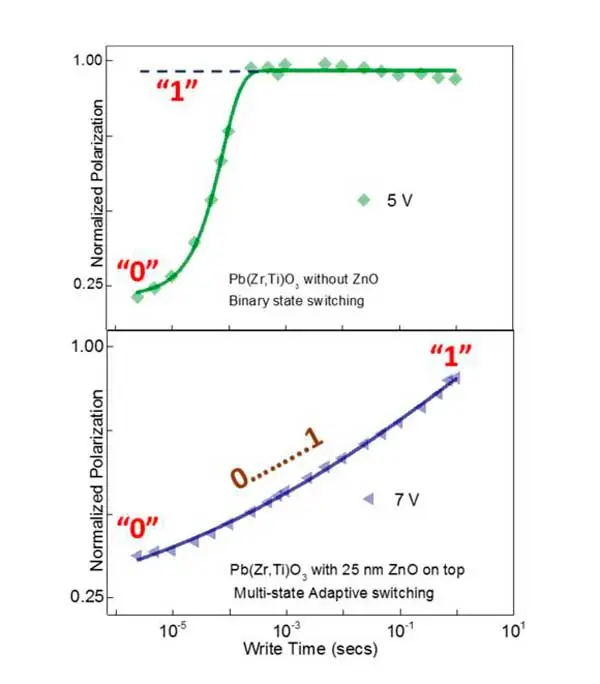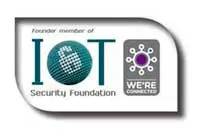Electronics News
Archive : 8 July 2016 год
 Scientists from the MESA+ Institute for Nanotechnology at the University of Twente have developed a ferro-electric material with a memory function resembling the synapses and neurons of the brain, resulting in a multistate memory.
Scientists from the MESA+ Institute for Nanotechnology at the University of Twente have developed a ferro-electric material with a memory function resembling the synapses and neurons of the brain, resulting in a multistate memory.
The material that could form the basic building blocks for ‘brain-inspired computing’ is lead-zirconium-titanate (PZT): a sandwich of materials with several attractive properties. One is that it is ferro-electric, which could lead to a fast, non-volatile memory function. When the UT scientists added a 25nm thin layer of zinc oxide to the PZT they discovered that switching from one state to another not only happens from ‘zero’ to ‘one’ and vice versa, it was also possible to control smaller areas within the crystal.
By using variable writing times in those smaller areas, the scientists say that many states can be stored anywhere between zero and one. This resembles the way synapses and neurons ‘weigh’ signals in our brain. Multistate memories, coupled to transistors, could drastically improve the speed of pattern recognition, for example: our brain performs this kind of task consuming only a fraction of the energy a computer system needs.

Looking at the graphs, the writing times seem quite long compared to current processor speeds, but it is possible to create many memories in parallel. The function of the brain has already been mimicked in software like neural networks, but in that case conventional digital hardware is still a limitation. The new material is a first step towards electronic hardware with a brain-like memory.
Finding solutions for combining PZT with semiconductors, or even developing new kinds of semiconductors for this, is one of the next steps for the UT team, which is also looking into the piezo-electric properties of the material.
Author
Tom Austin-Morgan
Source: www.newelectronics.co.uk
 Celebrating the 20th anniversary of its announcement of spin torque MRAM, IBM has outlined how it believes the technique can be used at process technology nodes of 11nm.
Celebrating the 20th anniversary of its announcement of spin torque MRAM, IBM has outlined how it believes the technique can be used at process technology nodes of 11nm.
The 1996 paper published by John Slonczewski was updated in 2011 by Dr Daniel Worledge and colleagues, who outlined a technique to produce MRAM with manufacturing line widths of less than 20nm. The approach – called perpendicular magnetic anisotropy (PMA) – was seen as a critical discovery because it would enable spin torque MRAM to scale to much higher densities.
What that team did was to develop magnetic materials that allowed the magnet to point perpendicularly, instead of in the plane. However, Dr Worledge and his colleagues believed they could scale even further, resulting in even denser MRAM.
Now, Dr Worledge and colleagues, along with partners at Samsung, have published a paper demonstrating how MRAM cells with diameters as small as 11nm can switch in 10ns using a current of 7.5µA.
“With PMA, we are capable of delivering good STT-MRAM performance down to write-error-rate of 7×10-10 with 10ns pulses and switching currents of 7.5µA. This could never be done with in-plane magnetised devices - they just don’t scale.
“While more research needs to be done, this should give the industry the confidence it needs to move forward. The time for Spin Torque MRAM is now.”
Author
Graham Pitcher
Source: www.newelectronics.co.uk
 The independent provider of embedded software development training and ARM training partner, Feabhas, has become a founder member of the IoT Security Foundation.
The independent provider of embedded software development training and ARM training partner, Feabhas, has become a founder member of the IoT Security Foundation.
Niall Cooling, CEO at Feabhas, said: “Many of today’s deeply embedded systems are now connected to other devices. While this brings some great benefits such as enhanced functionality, and makes updates easier to conduct online, it is not without risk. As deeply embedded systems have historically been isolated, they have not necessarily required such rigorous security to be in place. It is important therefore, that while they take advantage of today’s connected technology developments, they are protected from future security attacks.
“Like the IoT Security Foundation, we believe that: embedded systems security should be considered at the start and not as an afterthought, the method of security needs to be right for the embedded system (such as in the application layer, for example), and wherever possible, it needs to be resilient throughout the planned product lifecycle."
The IoT Security Foundation was launched in 2015 as a non-profit, collaborative organisation dedicated to propagating good security practice and acting as a resource for shared knowledge, best practice and advice. It counts members such as ARM, BT and Vodafone.
Author
Peggy Lee
Source: www.newelectronics.co.uk

